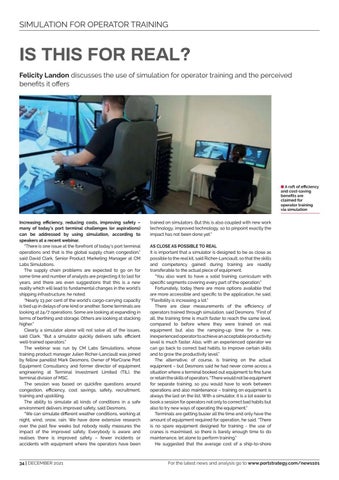SIMULATION FOR OPERATOR TRAINING
IS THIS FOR REAL? Felicity Landon discusses the use of simulation for operator training and the perceived benefits it offers
8 A raft of efficiency and cost-saving benefits are claimed for operator training via simulation
Increasing efficiency, reducing costs, improving safety – many of today’s port terminal challenges (or aspirations) can be addressed by using simulation, according to speakers at a recent webinar. “There is one issue at the forefront of today’s port terminal operations and that is the global supply chain congestion,” said David Clark, Senior Product Marketing Manager at CM Labs Simulations. The supply chain problems are expected to go on for some time and number of analysts are projecting it to last for years, and there are even suggestions that this is a new reality which will lead to fundamental changes in the world’s shipping infrastructure, he noted. “Nearly 13 per cent of the world’s cargo-carrying capacity is tied up in delays of one kind or another. Some terminals are looking at 24/7 operations. Some are looking at expanding in terms of berthing and storage. Others are looking at stacking higher.” Clearly a simulator alone will not solve all of the issues, said Clark. “But a simulator quickly delivers safe, efficient well-trained operators.” The webinar was run by CM Labs Simulations, whose training product manager Julien Richer-Lanciault was joined by fellow panellist Mark Desmons, Owner of MarCrane Port Equipment Consultancy and former director of equipment engineering at Terminal Investment Limited (TIL), the terminal division of MSC. The session was based on quickfire questions around congestion, efficiency, cost savings, safety, recruitment, training and upskilling. The ability to simulate all kinds of conditions in a safe environment delivers improved safety, said Desmons. “We can simulate different weather conditions, working at night, wind, snow, rain. We have done extensive research over the past few weeks but nobody really measures the impact of the improved safety. Everybody is aware and realises there is improved safety – fewer incidents or accidents with equipment where the operators have been
34 | DECEMBER 2021
trained on simulators. But this is also coupled with new work technology, improved technology, so to pinpoint exactly the impact has not been done yet.” AS CLOSE AS POSSIBLE TO REAL It is important that a simulator is designed to be as close as possible to the real kit, said Richer-Lanciault, so that the skills and competency gained during training are readily transferable to the actual piece of equipment. “You also want to have a solid training curriculum with specific segments covering every part of the operation.” Fortunately, today there are more options available that are more accessible and specific to the application, he said: “Flexibility is increasing a lot.” There are clear measurements of the efficiency of operators trained through simulation, said Desmons. “First of all, the training time is much faster to reach the same level, compared to before where they were trained on real equipment but also the ramping-up time for a new, inexperienced operator to achieve an acceptable productivity level is much faster. Also, with an experienced operator we can go back to correct bad habits, to improve certain skills and to grow the productivity level.” The alternative, of course, is training on the actual equipment – but Desmons said he had never come across a situation where a terminal booked out equipment to fine tune or retain the skills of operators. “There would not be equipment for separate training, so you would have to work between operations and also maintenance – training on equipment is always the last on the list. With a simulator, it is a lot easier to book a session for operators not only to correct bad habits but also to try new ways of operating the equipment.” Terminals are getting busier all the time and only have the amount of equipment required for operation, he said. “There is no spare equipment designed for training - the use of cranes is maximised, so there is barely enough time to do maintenance, let alone to perform training.” He suggested that the average cost of a ship-to-shore
For the latest news and analysis go to www.portstrategy.com/news101














